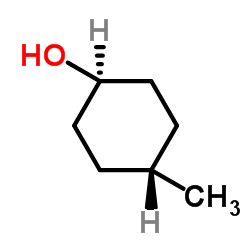trans-4-Methylcyclohexanol

trans-4-Methylcyclohexanol structure
|
Common Name | trans-4-Methylcyclohexanol | ||
|---|---|---|---|---|
| CAS Number | 7731-29-5 | Molecular Weight | 114.186 | |
| Density | 0.9±0.1 g/cm3 | Boiling Point | 170.3±8.0 °C at 760 mmHg | |
| Molecular Formula | C7H14O | Melting Point | N/A | |
| MSDS | Chinese USA | Flash Point | 70.0±0.0 °C | |
| Symbol |

GHS07 |
Signal Word | Warning | |
|
Behavioral responses to odorants in drosophila require nervous system expression of the beta integrin gene myospheroid.
Chem. Senses 31(7) , 627-39, (2006) Integrins are cell adhesion molecules that mediate numerous developmental processes in addition to a variety of acute physiological events. Two reports implicate a Drosophila beta integrin, betaPS, in olfactory behavior. To further investigate the role of int... |
|
|
Laser-induced fluorescence spectra of 4-methylcyclohexoxy radical and perdeuterated cyclohexoxy radical and direct kinetic studies of their reactions with O2.
J. Phys. Chem. A 109(41) , 9232-40, (2005) The laser-induced fluorescence (LIF) excitation spectra of the 4-methylcyclohexoxy and d11-cyclohexoxy radicals have been measured for the first time. LIF intensity was used as a probe in direct kinetic studies of the reaction of O(2) with trans-4-methylcyclo... |
|
|
Studies of 4-methylcyclohexanol: an Aedes triseriatus (Diptera: Culicidae) oviposition attractant.
J. Med. Entomol. 19(5) , 589-92, (1982)
|
|
|
Laboratory tests of the effects of p-cresol and 4-methylcyclohexanol on oviposition by three species of Toxorhynchites mosquitoes.
Med. Vet. Entomol. 3(4) , 347-52, (1989) Laboratory experiments tested the effects of p-cresol or 4-methylcyclohexanol at concentrations of 1, 10 and 50 ppm, on oviposition by the mosquitoes Toxorhynchites brevipalpis Theobald, Tx. amboinensis (Doleschall) and Tx. splendens (Wiedemann). A 5 + 5 ppm ... |
|
|
Drosophila olfactory response rhythms require clock genes but not pigment dispersing factor or lateral neurons.
J. Biol. Rhythms 20(3) , 237-44, (2005) Odors elicit a number of behavioral responses, including attraction and repulsion in Drosophila. In this study, the authors used a T-maze apparatus to show that wild-type Drosophila melanogaster exhibit a robust circadian rhythm in the olfactory attractive an... |
|
|
Attention deficit induced by blockade of N-methyl D-aspartate receptors in the prefrontal cortex is associated with enhanced glutamate release and cAMP response element binding protein phosphorylation: role of metabotropic glutamate receptors 2/3.
Gene 245(1) , 31-42, (2000) The hypothesis that attention deficits induced by the hypofunction of N-methyl d-aspartate (NMDA) receptors in the prefrontal cortex (PFC) might be associated with increased glutamate release and changes in the phosphorylation of the cyclic adenosine monophos... |
|
|
Crossmodal interactions between olfactory and visual learning in Drosophila.
Science 309(5732) , 307-10, (2005) Different modalities of sensation interact in a synergistic or antagonistic manner during sensory perception, but whether there is also interaction during memory acquisition is largely unknown. In Drosophila reinforcement learning, we found that conditioning ... |
|
|
Biological enantioselective reduction of methylcyclohexanones by Glomerella cingulata. Miyazawa M, et al.
J. Chem. Technol. Biotechnol. 65(2) , 171-175, (1996)
|